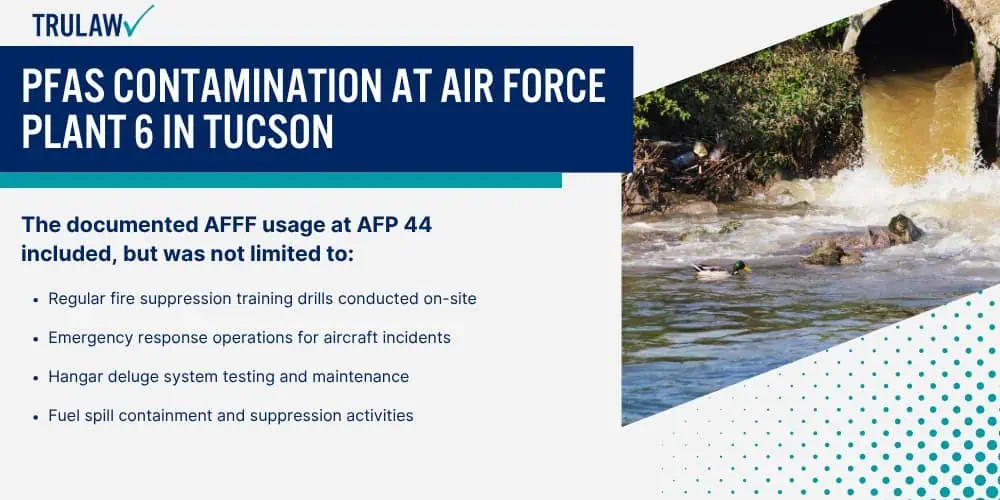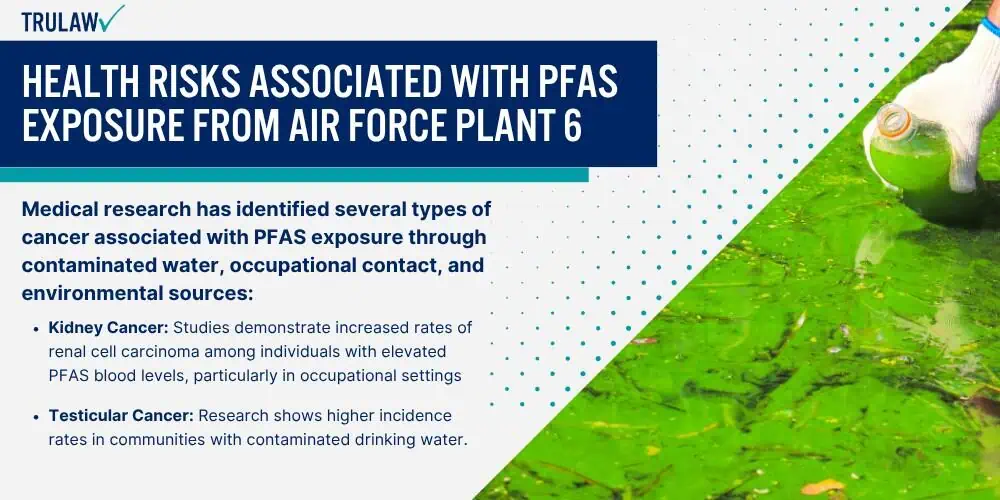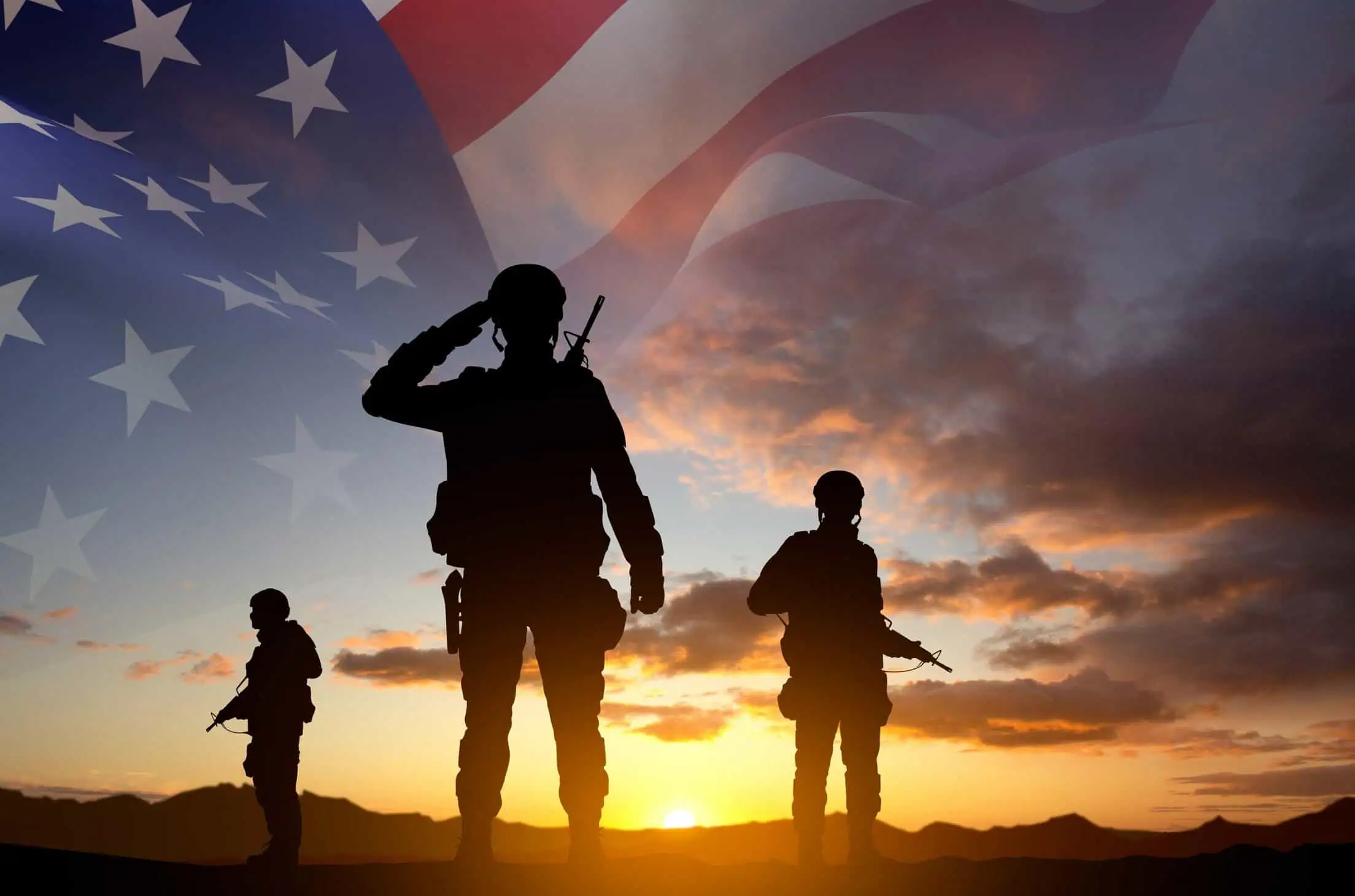Air Force Plant 6, also known as Air Force Plant 44 (AFP 44), sits within the sprawling Tucson International Airport Area Superfund Site, where decades of industrial operations have created a 10-square-mile zone of groundwater contamination affecting thousands of residents.

The facility, located approximately eight miles south of downtown Tucson, has emerged as a focus in nationwide PFAS litigation as contamination levels reaching 53,000 parts per trillion—over 13,000 times the EPA’s safety standard—continue to threaten public health and force costly remediation efforts throughout the region.
The History of AFFF Use at Air Force Plant 6
Military installations across the United States began using Aqueous Film Forming Foam (AFFF) in the 1970s as a primary firefighting agent for fuel-based fires, and Air Force Plant 6 followed this standard protocol for decades.
The facility utilized AFFF extensively during crash crew training exercises, hangar system operations, equipment testing, and emergency response situations from the 1970s through recent years, releasing thousands of gallons of the PFAS-laden foam into the environment.
The documented AFFF usage at AFP 44 included, but was not limited to:
- Regular fire suppression training drills conducted on-site
- Emergency response operations for aircraft incidents
- Hangar deluge system testing and maintenance
- Equipment calibration and functionality checks
- Fuel spill containment and suppression activities
These firefighting foams, prized for their ability to quickly suppress petroleum-based fires, contained high concentrations of per- and polyfluoroalkyl substances (PFAS) that would ultimately seep through soil and concrete, creating a toxic plume in the regional aquifer.
While the EPA has established a safety standard of just 4 parts per trillion for certain PFAS compounds in drinking water, PFAS detected at the Tucson Airport Remediation Project (TARP) treatment plant revealed contamination levels as high as 53,000 parts per trillion—a concentration that represents an extraordinary public health threat requiring immediate intervention.
Current Contamination Levels and Affected Areas
The PFAS pollution emanating from Air Force Plant 6 has created an environmental crisis spanning approximately 10 square miles, encompassing not only the Tucson International Airport but also the Morris Air National Guard Base and surrounding residential communities.
This expansive contamination zone threatens the water supply for tens of thousands of Tucson residents, with the toxic plume continuing to migrate northwest through the aquifer system toward additional municipal wells.
The most severely impacted areas include, but are not limited to:
- Tucson Airport Remediation Project (TARP) wellfield system
- Residential neighborhoods north of Los Reales Road
- San Xavier District of the Tohono O’odham Nation
- Communities surrounding Hughes Access Road
- Areas adjacent to Nogales Highway (Route 89)
The scope of this environmental disaster has forced the City of Tucson to shut down 31 municipal wells to prevent further exposure to contaminated water, creating strain on the city’s water infrastructure and supply capacity.
According to the city’s December 2024 lawsuit, Tucson has already invested $71.1 million in PFAS-related remediation efforts, including specialized laboratory equipment to analyze over 1,800 water samples annually, construction of new pretreatment facilities and filtration systems, and ongoing operational costs for alternative water sources to serve affected communities.
If you or a loved one consumed PFAS-contaminated water from wells near Air Force Plant 6 and developed serious health conditions, you may be eligible to seek compensation.
Contact TruLaw using the chat on this page to receive an instant case evaluation that can help you determine if you qualify to file a PFAS Water Contamination Lawsuit today.
EPA Emergency Order and Air Force Response
The Environmental Protection Agency issued an emergency administrative order in May 2024 directing the U.S. Air Force and Arizona National Guard to immediately address the PFAS contamination threatening Tucson’s drinking water supply.
The order emphasized that no extraction and treatment system existed for containing or treating PFAS-contaminated groundwater from AFP 44 or the Morris Air National Guard Base, allowing toxic chemicals to continue migrating throughout the regional aquifer unchecked.
The Air Force responded to EPA enforcement actions through several documented legal and administrative measures:
- Challenged EPA Authority: Filed legal briefs citing the Supreme Court’s 2024 Chevron doctrine ruling to question the EPA’s regulatory power over military installations
- Jurisdictional Disputes: Argued that federal military facilities fall outside EPA’s enforcement scope for environmental contamination remediation
- Non-compliance with Emergency Orders: Declined to implement immediate remediation measures requested by EPA for contaminated groundwater sites
- Delayed Required Documentation: Failed to meet submission deadlines for contamination investigation reports and cleanup action plans mandated under federal environmental law
- Contested Financial Liability: Disputed responsibility for funding community water treatment systems and environmental restoration costs related to PFAS contamination
However, mounting public pressure and the threat of substantial penalties led to a shift in October 2024, when the Air Force reached a compliance agreement with the EPA to begin addressing the contamination crisis.
The agreement establishes a framework for cost-sharing on treatment infrastructure, with the Air Force committing to cover 50% of expenses for new PFAS removal systems while also conducting comprehensive site investigations under the Comprehensive Environmental Response, Compensation, and Liability Act (CERCLA) to determine the full extent of contamination and develop long-term remediation strategies.







